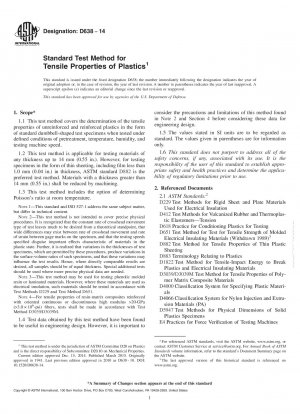ASTM D638-14
Standard Test Method for Tensile Properties of Plastics
- Standard No.
- ASTM D638-14
- Release Date
- 2014
- Published By
- American Society for Testing and Materials (ASTM)
- Status
- Replace By
- ASTM D638-22
- Latest
- ASTM D638-22
- Scope
4.1 This test method is designed to produce tensile property data for the control and specification of plastic materials. These data are also useful for qualitative characterization and for research and development.
4.2 Some material specifications that require the use of this test method, but with some procedural modifications that take precedence when adhering to the specification. Therefore, it is advisable to refer to that material specification before using this test method. Table 1 in Classification D4000 lists the ASTM materials standards that currently exist.
4.3 Tensile properties are known to vary with specimen preparation and with speed and environment of testing. Consequently, where precise comparative results are desired, these factors must be carefully controlled.
4.4 It is realized that a material cannot be tested without also testing the method of preparation of that material. Hence, when comparative tests of materials per se are desired, exercise great care to ensure that all samples are prepared in exactly the same way, unless the test is to include the effects of sample preparation. Similarly, for referee purposes or comparisons within any given series of specimens, care shall be taken to secure the maximum degree of uniformity in details of preparation, treatment, and handling.
4.5 Tensile properties provide useful data for plastics engineering design purposes. However, because of the high degree of sensitivity exhibited by many plastics to rate of straining and environmental conditions, data obtained by this test method cannot be considered valid for applications involving load-time scales or environments widely different from those of this test method. In cases of such dissimilarity, no reliable estimation of the limit of usefulness can be made for most plastics. This sensitivity to rate of straining and environment necessitates testing over a broad load-time scale (including impact and creep) and range of environmental conditions if tensile properties are to suffice for engineering design purposes.
Note 5: Since the existence of a true elastic limit in plastics (as in many other organic materials and in many metals) is debatable, the propriety of applying the term “elastic modulus” in its quoted, generally accepted definition to describe the “stiffness” or “rigidity” of a plastic has been seriously questioned. The exact stress-strain characteristics of plastic materials are highly dependent on such factors as rate of application of stress, temperature, previous history of specimen, etc. However, stress-strain curves for plastics, determined as described in this test method, almost always show a linear region at low stresses, and a straight line drawn tangent to this portion of the curve permits calculation of an elastic modulus of the usually defined type. Such a constant is useful if its arbitrary nature and dependence on time, temperature, and similar factors are realized.
1.1 This test method covers the determination of the tensile properties of unreinforced and reinforced plastics in the form of standard dumbbell-shaped test specimens when tested under defined conditions ......
ASTM D638-14 Referenced Document
- ASTM D1822 Standard Test Method for Tensile-Impact Energy to Break Plastics and Electrical Insulating Materials
- ASTM D229 Standard Test Methods for Rigid Sheet and Plate Materials Used for Electrical Insulation
- ASTM D3039/D3039M Standard Test Method for Tensile Properties of Polymer Matrix Composite Materials
- ASTM D4000 Standard Classification System for Specifying Plastic Materials
- ASTM D4066 Standard Classification System for Nylon Injection and Extrusion Materials (PA)
- ASTM D412 Standard Test Methods for Vulcanized Rubber and Thermoplastic Elastomers8212;Tension
- ASTM D5947 Standard Test Methods for Physical Dimensions of Solid Plastics Specimens
- ASTM D618 Standard Practice for Conditioning Plastics for Testing
- ASTM D882 Standard Test Method for Tensile Properties of Thin Plastic Sheeting
- ASTM D883 Standard Terminology Relating to Plastics
- ASTM E132 Standard Test Method for Poisson''s Ratio at Room Temperature
- ASTM E4 Standard Practices for Force Verification of Testing Machines
- ASTM E691 Standard Practice for Conducting an Interlaboratory Study to Determine the Precision of a Test Method
- ASTM E83 Standard Practice for Verification and Classification of Extensometer
- ISO 527-1 Plastics — Determination of tensile properties — Part 1: General principles
ASTM D638-14 history
- 2022 ASTM D638-22 Standard Test Method for Tensile Properties of Plastics
- 2014 ASTM D638-14 Standard Test Method for Tensile Properties of Plastics
- 2010 ASTM D638-10 Standard Test Method for Tensile Properties of Plastics
- 2008 ASTM D638-08 Standard Test Method for Tensile Properties of Plastics
- 2003 ASTM D638-03 Standard Test Method for Tensile Properties of Plastics
- 2002 ASTM D638-02a Standard Test Method for Tensile Properties of Plastics
- 2002 ASTM D638-02 Standard Test Method for Tensile Properties of Plastics
- 2001 ASTM D638-01 Standard Test Method for Tensile Properties of Plastics
- 2002 ASTM D638-00 Standard Test Method for Tensile Properties of Plastics
- 1999 ASTM D638-99 Standard Test Method for Tensile Properties of Plastics

Copyright ©2024 All Rights Reserved